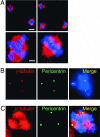Rae1 interaction with NuMA is required for bipolar spindle formation
- PMID: 17172455
- PMCID: PMC1750899
- DOI: 10.1073/pnas.0609582104
Rae1 interaction with NuMA is required for bipolar spindle formation
Abstract
In eukaryotic cells, the faithful segregation of daughter chromosomes during cell division depends on formation of a microtubule (MT)-based bipolar spindle apparatus. The Nuclear Mitotic Apparatus protein (NuMA) is recruited from interphase nuclei to spindle MTs during mitosis. The carboxy terminal domain of NuMA binds MTs, allowing a NuMA dimer to function as a "divalent" crosslinker that bundles MTs. The messenger RNA export factor, Rae1, also binds to MTs. Lowering Rae1 or increasing NuMA levels in cells results in spindle abnormalities. We have identified a mitotic-specific interaction between Rae1 and NuMA and have explored the relationship between Rae1 and NuMA in spindle formation. We have mapped a specific binding site for Rae1 on NuMA that would convert a NuMA dimer to a "tetravalent" crosslinker of MTs. In mitosis, reducing Rae1 or increasing NuMA concentration would be expected to alter the valency of NuMA toward MTs; the "density" of NuMA-MT crosslinks in these conditions would be diminished, even though a threshold number of crosslinks sufficient to stabilize aberrant multipolar spindles may form. Consistent with this interpretation, we found that coupling NuMA overexpression to Rae1 overexpression or coupling Rae1 depletion to NuMA depletion prevented the formation of aberrant spindles. Likewise, we found that overexpression of the specific Rae1-binding domain of NuMA in HeLa cells led to aberrant spindle formation. These data point to the Rae1-NuMA interaction as a critical element for normal spindle formation in mitosis.
Conflict of interest statement
The authors declare no conflict of interest.
Figures





References
Publication types
MeSH terms
Substances
LinkOut - more resources
Full Text Sources
Other Literature Sources
Molecular Biology Databases
Research Materials
Miscellaneous

